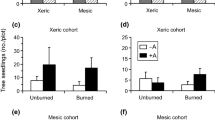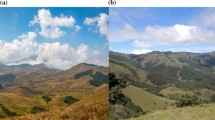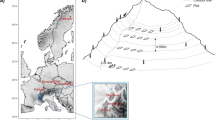Abstract
Anthropogenic activities have increased disturbances and alien woody invasion in mountain ecosystems worldwide. Whether disturbances promote or counteract upward movement of woody aliens is poorly understood. We assessed if the most successful woody invader of low mountains of central Argentina (Gleditsia triacanthos) might expand its elevational distribution in response to the principal disturbances of these ecosystems (fire and livestock browsing) across increasing climatic severity. We assessed seedling emergence, growth and mycorrhizal colonization on sown plots distributed in burned and unburned sites, with and without browsing at the lower and upper elevation belts (i.e. 1000 and 2400 m a.s.l.). Additionally, several abiotic variables were measured to relate their influence on the seedling establishment. Disturbances reduced seedling emergence at both elevations. Burned conditions increased seedling growth and arbuscular colonization only in the lower belt. Seedling success (total seedling biomass per plot) was not modified by disturbances at the upper elevation, but was reduced by browsing and enhanced by fire in the lower elevation. The overall reduction in seedling emergence and growth in the upper elevation despite the higher soil nutrient content places climate as the strongest regulator of G. triacanthos seedling establishment. Accordingly, climate rather than disturbances would be the main limiting factor of upward expansion of this woody alien. Our findings differ from general patterns described for mountain invasion by herbaceous species, highlighting that mountain invasibility is highly growth-form dependent, and that upper range expansion by woody aliens interacting with multiple disturbances should be assessed worldwide.



Similar content being viewed by others
References
Adams SN (1975) Sheep and cattle grazing in forests: a review. J Appl Ecol 12(1):143–152. https://doi.org/10.2307/2401724
Alba C, Skálová H, McGregor KF, D’Antonio C, Pyšek P (2015) Native and exotic plant species respond differently to wildfire and prescribed fire as revealed by meta-analysis. J Veg Sci 26(1):102–113. https://doi.org/10.1111/jvs.12212
Alexander JM, Lembrechts JJ, Cavieres LA, Daehler C, Haider S, Kueffer C, Liu G, McDougall K, Milbau A, Pauchard A, Rew LJ, Seipel T (2016) Plant invasions into mountains and alpine ecosystems: current status and future challenges. Alp Bot 126(2):89–103. https://doi.org/10.1007/s00035-016-0172-8
Ansari S, Daehler DD (2010) Life history variation in a temperate plant invader, Verbascum thapsus along a tropical elevational gradient in Hawaii. Biol Invasions 12(12):4033–4047. https://doi.org/10.1007/s10530-010-9810-z
Argañaraz JP, Pizarro GG, Zak M, Bellis LM (2015) Fire regime, climate, and vegetation in the Sierras de Córdoba, Argentina. Fire Ecol 11(1):55–73. https://doi.org/10.4996/fireecology.1101055
Arnan X, Rodrigo A, Retana J (2007) Uncoupling the effects of shade and food resources of vegetation on mediterranean ants: an experimental approach at the community level. Ecography 30(2):161–172. https://doi.org/10.1111/j.0906-7590.2007.04796.x
Callaway RM, Brooker RW, Choler P, Kikvidze Z, Lortie CJ, Michalet R, Paolini L, Pugnaire FI, Newingham B, Aschehoug ET, Armas C, Kikodze D, Cook BJ (2002) Positive interactions among alpine plants increase with stress. Nature 417(6891):844–848. https://doi.org/10.1038/nature00812
Capó EA, Aguilar R, Renison D (2016) Livestock reduces juvenile tree growth of alien invasive species with a minimal effect on natives: a field experiment using exclosures. Biol Invasions 18(10):2943–2950. https://doi.org/10.1007/s10530-016-1185-3
Certini G (2005) Effects of fire on properties of forest soils: a review. Oecologia 143:1–10. https://doi.org/10.1007/s00442-004-1788-8
Chagnon PL, Bradley RL, Maherali H, Klironomos JN (2013) A trait-based framework to understand life history of mycorrhizal fungi. Trends Plant Sci 9:484–491. https://doi.org/10.1016/j.tplants.2013.05.001
Chaneton EJ, Mazía J, Machera M, Uchitel A, Ghersa CM (2004) Establishment of Honey Locust (Gleditsia triacanthos) in burned pampean grasslands. Weed Technol 18(1):1325–1329. https://doi.org/10.1614/0890-037X(2004)018[1325:EOHLGT]2.0.CO;2
Cingolani AM, Cabido MR, Renison D, Solís Neffa V (2003) Combined effects of environment and grazing on vegetation structure in Argentine granite grasslands. J Veg Sci 14(2):223–232. https://doi.org/10.1016/j.rse.2004.05.008
Cingolani AM, Renison D, Zak M, Cabido M (2004) Mapping vegetation in a heterogeneous mountain rangeland using Landsat data: an alternative method to define and classify land-cover units. Remote Sens Environ 92(1):84–97. https://doi.org/10.1111/j.1654-1103.2003.tb02147.x
Colladon L, Felici GS, Pazos I. (2010) Anuario pluviométrico 2005 -2010. Cuenca del río San Antonio: Sistema del Río Suquía, Provincia de Córdoba. 1st edn. Instituto Nacional del Agua, Villa Carlos Paz
D’Antonio CM, Hughes RF, Vitousek PM (2001) Factors influencing dynamics of two invasive C4 grasses in seasonally dry Hawaiian woodlands. Ecology 82(1):89–104. https://doi.org/10.1890/0012-9658(2001)082[0089:FIDOTI]2.0.CO;2
De Steven D (1991) Experiments on mechanisms of tree establishment in old-field succession: seedling emergence. Ecology 72(3):1066–1075. https://doi.org/10.2307/1940606
Dietz H, Edwards JP (2006) Recognition that causal processes change during plant invasion helps explain conflicts in evidence. Ecology 87:1359–1367. https://doi.org/10.1890/0012-9658(2006)87[1359:RTCPCD]2.0.CO;2
Fernández RD, Ceballos SJ, Malizia A, Aragón R (2017) Gleditsia triacanthos (Fabaceae) in Argentina: a review of its invasion. Aust J Bot 65:203–213. https://doi.org/10.1071/BT16147
Ferreras AE, Galetto L (2010) From seed production to seedling establishment: important steps in an invasive process. Acta Oecol 36(2):211–218. https://doi.org/10.1016/j.actao.2009.12.005
Ferreras AE, Funes G, Galetto L (2015) The role of seed germination in the invasion process of Honey locust (Gleditsia triacanthos L., Fabaceae): comparison with a native confamilial. Plant Species Biol 30(2):126–136. https://doi.org/10.1111/1442-1984.12041
Gai JP, Tian H, Yang FY, Christie P, Li XL, Klironomos JN (2012) Arbuscular mycorrhizal fungal diversity along a Tibetan elevation gradient. Pedobiol 55:145–151. https://doi.org/10.1016/j.pedobi.2011.12.004
Gehring CA, Whitham TG (1994) Interactions between aboveground herbivores and the mycorrhizal mutualists of plants. Trends Ecol Evol 9(7):251–255. https://doi.org/10.1016/0169-5347(94)90290-9
Gimeno-García E, Andreu V, Rubio JL (2000) Changes in organic matter, nitrogen, phosphorus and cations in soil as a result of fire and water erosion in a Mediterranean landscape. Eur J Soil Sci 51(2):201–210. https://doi.org/10.1046/j.1365-2389.2000.00310.x
Giorgis M, Tecco PA (2014) Árboles y arbustos invasores de la provincia de Córdoba (Argentina): una contribución a la sistematización de bases de datos globales. B Soc Argent Bot 49(4):581–603
Giorgis MA, Tecco PA, Cingolani AM, Renison D, Marcora PI, Paiaro V (2011a) Factors associated with woody alien species distribution in a newly invaded mountain system of central Argentina. Biol Invasions 13(6):1423–1434. https://doi.org/10.1007/s11258-009-9674-4
Giorgis MA, Cingolani AM, Chiarini F, Chiapella J, Barboza G, Espinar LA, Moreno R, Gurvich DE, Tecco PA, Subils R, Cabido M (2011b) Composición florística del bosque chaqueño serrano de la provincia de Córdoba. Argentina. Kurtziana 36(1):9–43
Giorgis MA, Cingolani AM, Tecco PA, Cabido MR, Poca M, von Wehrden H (2016) Testing alien plant distribution and habitat invasibility in mountain ecosystems: growth form matters. Biol Invasions 18(7):2017–2028. https://doi.org/10.1007/s10530-016-1148-8
Grace C, Stribley DP (1991) A safer procedure for routine staining of vesicular-arbuscular mycorrhizal fungi. Mycol Res 95(10):1160–1162. https://doi.org/10.1016/S0953-7562(09)80005-1
Grümberg BC, Urcelay C, Shroeder MA, Vargas-Gil S, Luna MC (2015) The role of inoculums identity in drought stress mitigation by arbuscular mycorrhizal fungi in soybean. Biol Fertil Soils 51(1):1–10. https://doi.org/10.1007/s00374-014-0942-7
Gundale MJ, Kardol P, Nilsson MC, Nilsson U, Lucas RW, Wardle DA (2014) Interactions with soil biota shift from negative to positive when a tree species is moved outside its native range. New Phytol 202(2):415–421. https://doi.org/10.1111/nph.12699
Herrero ML, Torres R, Renison D (2016) Do wildfires promote woody species invasion in a fire-adapted ecosystem? Post-fire resprouting of native and non-native woody plants in central Argentina. Environ Manage 57(2):308–317. https://doi.org/10.1007/s00267-015-0616-8
Jaureguiberry P, Díaz S (2015) Post-burning regeneration of the chaco seasonally dry forest: germination response of dominant species to experimental heatshock. Oecologia 177(3):689–699. https://doi.org/10.1007/s00442-014-3161-x
Kimball S, Schiffman P (2003) Differing effects of cattle grazing on native and alien plants. Conserv Biol 17(6):1681–1693. https://doi.org/10.1111/j.1523-1739.2003.00205.x
Körner C (1999) Alpine plant life. Springer, Berlin
Kozlowski TT (1999) Soil compaction and growth of woody plants. Scand J For Res 14:596–619
Larson DL, Anderson PJ, Newton W (2001) Alien plant invasion in mixed-grass prairie: effects of vegetation type and anthropogenic disturbance. Ecol App 11(1):128–141. https://doi.org/10.1890/1051-0761(2001)011%5B0128:APIIMG%5D2.0.CO;2
Lembrechts JJ, Milbau A, Nijs I (2015) Trade-off between competition and facilitation defines gap colonization in mountains. AoB Plants 7:1–13. https://doi.org/10.1093/aobpla/plv128 (plv128)
Lembrechts JJ, Pauchard A, Lenoir J, Nuñez MA, Geron C, Ven A, Bravo-Monasterio P, Teneb E, Nijs I, Milbau A (2016) Disturbance is the key to plant invasions in cold environments. Proc Natl Acad Sci USA 113(49):14061–14066. https://doi.org/10.1073/pnas.1608980113
Little EL Jr (1971) Conifers and important hardwoods. In: Atlas of United States trees, vol 1. 1st edn. US department of agriculture, Washington
Longo S, Nouhra E, Goto BT, Berbara RL, Urcelay C (2014) Effects of fire on arbuscular mycorrhizal fungi in the mountain chaco forest. For Ecol Manag 315:86–94. https://doi.org/10.1016/j.foreco.2013.12.027
Longo S, Cofré N, Soteras F, Grilli G, Lugo M, Urcelay C (2016) Taxonomic and functional response of arbuscular mycorrhizal fungi to land use change in central Argentina. In: Pagano MC (ed) Recent advances on mycorrhizal fungi. Springer, Cham, pp 81–90. https://doi.org/10.1007/978-3-319-24355-9_7
Lonsdale WM (1999) Global patterns of plant invasions and the concept of invasibility. Ecology 80(5):1522–1536. https://doi.org/10.1890/0012-9658(1999)080[1522:GPOPIA]2.0.CO;2
Marcora PI, Hensen I, Renison D, Seltmann P, Wesche K (2008) The performance of Polylepis australis trees along their entire altitudinal range: implications of climate change for their conservation. Divers Distributions 14(4):630–636. https://doi.org/10.1111/j.1472-4642.2007.00455.x
Marcora PI, Renison D, Pais-Bosch AI, Cabido M, Tecco PA (2013) The effect of altitude and grazing on seedling establishment of woody species in central Argentina. For Ecol Manag 291:300–307. https://doi.org/10.1016/j.foreco.2012.11.030
Mazía NC, Chaneton EJ, Ghersa CM, León RJ (2001) Limits to tree species invasion in pampean grassland and forest plant communities. Oecologia 128(4):594–602. https://doi.org/10.1007/s004420100709
Mazía CN, Chaneton EJ, Machera M, Uchitel A, Feler MV, Ghersa CM (2010) Antagonistic effects of large-and small-scale disturbances on exotic tree invasion in a native tussock grassland relict. Biol Invasions 12(9):3109–3122. https://doi.org/10.1007/s10530-010-9702-2
McGonigle TP, Miller MH, Evans DG, Fairchild GL, Swan JA (1990) A new method which gives an objective measure of colonization of roots by vesicular—arbuscular mycorrhizal fungi. New Phytol 115(3):495–501. https://doi.org/10.1111/j.1469-8137.1990.tb00476.x
Milbau A, Shevtsova A, Osler N, Mooshammer M, Graae B (2013) Plant community type and small-scale disturbances, but not altitude, influence the invisibility in subarctic ecosystems. New Phytol 197(3):1002–1011
Millennium Ecosystem Assessment (2005) Millennium Ecosystem Assessment Ecosystems and human well-being: Biodiversity synthesis. World Resources Institute, Washington
Muschetto E, Mazía N, Cueto GR, Busch M (2015) Are rodents a source of biotic resistance to tree invasion in Pampean grasslands? Tree seed consumption under different conditions. Aust Ecol 40(3):255–266. https://doi.org/10.1111/aec.12208
van der Heyde M, Ohsowski BM, Abbott LK, Hart M (2017) Arbuscular mycorrhizal fungus responses to disturbance are context-dependent. Mycorrhiza 27:431–440
Nuñez MA, Dickie IA (2014) Invasive belowground mutualists of woody plants. Biol Invasions 16(3):645–661. https://doi.org/10.1007/s10530-013-0612-y
Ordóñez JL, Retana J (2004) Early reduction of post-fire recruitment of Pinus nigra by post-dispersal seed predation in different time-since-fire habitats. Ecography 27(4):449–458. https://doi.org/10.1111/j.0906-7590.2004.03886.x
Pauchard A, Kueffer C, Dietz H, Daehler CC, Alexander J, Edwards PJ, Arévalo JR, Cavieres LA, Guisan A, Haider S, Jakobs G, McDougall K, Millar CI, Naylor BJ, Parks CG, Rew LJ, Seipel T (2009) Ain’t no mountain high enough: plant invasions reaching new elevations. Front Ecol Environ 7(9):479–486. https://doi.org/10.1890/080072
Poll M, Naylor BJ, Alexander JM, Edwards PJ, Dietz H (2009) Seedling establishment of Asteraceae forbs along altitudinal gradients: a comparison of transplant experiments in the native and introduced ranges. Divers Distributions 15(2):254–265. https://doi.org/10.1111/j.1472-4642.2008.00540.x
Pyšek P, Jarošik V, Pergl J, Wild J (2011) Colonization of high altitudes by alien plants over the last two centuries. PNAS 108(2):439–440
Quiroz C, Cavieres L, Pauchard A (2011) Assessing the importance of disturbance, site conditions, and the biotic barrier for dandelion invasion in an Alpine habitat. Biol Invasions 13:2889–2899. https://doi.org/10.1007/s10530-011-9971-4
Rejmánek M, Richardson DM (2013) Trees and shrubs as invasive alien species—2013 update of the global database. Divers Distributions 19(8):1093–1094. https://doi.org/10.1111/ddi.12075
Relva MA, Nuñez M, Simberloff D (2010) Introduced deer reduced native plant cover and facilitate invasion of non-native tree species: evidence for invasional meltdown. Biol Invasions 12:303–311. https://doi.org/10.1007/s10530-009-9623-0
Richardson DM, Rejmánek M (2011) Trees and shrubs as invasive alien species—a global review. Divers Distributions 17(5):788–809. https://doi.org/10.1111/j.1472-4642.2011.00782.x
Richardson DM, Hui C, Nuñez MA, Pauchard A (2014) Tree invasions: patterns, processes, challenges and opportunities. Biol Invasions 16(3):473–481. https://doi.org/10.1007/s10530-013-0606-9
Smith S, Read D (2008) Colonization of roots and anatomy of arbuscular mycorrhiza. Mycorrhizal Symbiosis. Academic Press, London
Stevens JT, Latimer AM (2015) Snowpack, fire, and forest disturbance: interactions affect montane invasions by non-native shrubs. Glob Change Biol 21(6):2379–2393. https://doi.org/10.1111/gcb.12824
te Beest M, Mpandza NJ, Olff H (2015) Fire and simulated herbivory have antagonistic effects on resistance of savanna grasslands to alien shrub invasion. J Veg Sci 26(1):114–122. https://doi.org/10.1111/jvs.12208
R Development Core Team (2016) R: A language and environment for statistical computing. Foundation for statistical computing. Vienna, Austria. http://www.R-roject.org. Accessed 17 Mar 2016
Tecco PA, Urcelay C, Días S, Cabido M, Pérez-Harguindeguy N (2013) Contrasting functional trait sindromes underlay woody alien success in the same ecosystem. Aust Ecol 38(4):443–451. https://doi.org/10.1111/j.1442-9993.2012.02428.x
Tecco PA, Pais-Bosch AI, Funes G, Marcora PI, Zeballos SR, Cabido M, Urcelay C (2016) Mountain invasions on the way: are there climatic constraints for the expansion of alien woody species along an elevation gradient in Argentina? J Plant Ecol 9(4):380–392. https://doi.org/10.1093/jpe/rtv064
Tjelele J, Ward D, Dziba L (2015) The effects of seed ingestion by livestock, dung fertilization, trampling, grass competition and fire on seedling establishment of two woody plant species. PLoS One 10(2):e0117788. https://doi.org/10.1371/journal.pone.0117788
Torres RC, Giorgis MA, Trillo C, Volkmann L, Demaio P, Heredia J, Renison D (2014) Post-fire recovery occurs overwhelmingly by resprouting in the chaco serrano forest of central Argentina. Austral Ecol 39(3):346–354. https://doi.org/10.1111/aec.12084
Urcelay C, Longo S, Geml J, Tecco PA, Nouhra E (2017) Co-invasive exotic pines and their ectomycorrhizal symbionts show capabilities for wide distance and altitudinal range expansion. Fungal Ecol 25:50–58. https://doi.org/10.1016/j.funeco.2016.11.002
Sala OE, Chapin FS, Armesto JJ, Berlow E, Bloomfield J, Dirzo R, Huber-Sanwald E, Huenneke LF, Jackson RB, Kinzig A, Leemans R, Lodge DM, Mooney HA, Oesterheld M (2000) Global biodiversity scenarios for the year 2100. Science 287(5459):1770–1774. https://doi.org/10.1126/science.287.5459.1770
Zeballos SR, Tecco PA, Cabido M, Gurvich DE (2014) Composición de especies leñosas en comunidades invadidas en montañas del centro de Argentina: su relación con factores ambientales locales. Rev Biol Trop 62(4):1673–1681
Acknowledgements
Authors acknowledge the assistance of Consejo Nacional de Investigaciones Científicas y Técnicas (CONICET), and Secretaría de Ciencia y Técnica (SECyT) of Universidad Nacional de Córdoba, both of which supported this investigation. We also thank M. Cabido for promoting this project, E. Kowaljow for field assistance, M. Pereyra for identification of ant species and J. Brasca for English edition of this article. We especially thank land owners (J. Astrada, Atum Pampa, Olguín), who provided access to the study site. The authors specially acknowledge the suggestions of the editor and two anonymous reviewers that improved the article.
Author information
Authors and Affiliations
Contributions
MP, FA and TP conceived the ideas and designed methodology; MP, FA, TP, FG and ZS collected the data; UC and LS measured mycorrhizal colonization; MP, FA, TP and ZS analyzed the data; all authors were involved in the writing of the manuscript, contributed critically to the drafts and gave final approval for publication.
Corresponding author
Ethics declarations
Disclosure of potential conflicts of interest
The authors declare that they have no conflict of interest.
Additional information
Communicated by Edith B. Allen.
Electronic supplementary material
Below is the link to the electronic supplementary material.
Rights and permissions
About this article
Cite this article
Marcora, P.I., Ferreras, A.E., Zeballos, S.R. et al. Context-dependent effects of fire and browsing on woody alien invasion in mountain ecosystems. Oecologia 188, 479–490 (2018). https://doi.org/10.1007/s00442-018-4227-y
Received:
Accepted:
Published:
Issue Date:
DOI: https://doi.org/10.1007/s00442-018-4227-y




